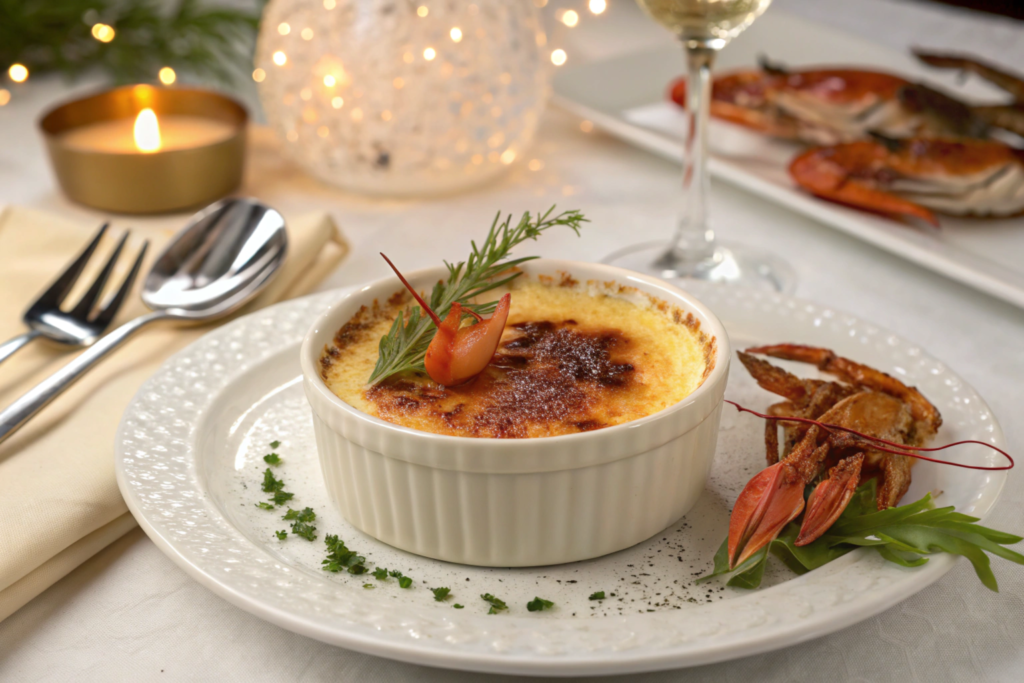Understanding the Science Behind Crème Brûlée
The delicate balance of eggs, cream, and sugar forms the foundation of crème brûlée. To get the custard just right, you need to bake it evenly and avoid curdling the eggs. Using a water bath (also called a bain-marie) ensures that the custard cooks uniformly by distributing heat evenly around the ramekins.
For those looking for inspiration with creamy dishes, check out the sweet potato and bacon casserole for another rich and flavorful recipe.
Visual and Physical Cues for Doneness
The key to perfect crème brûlée is recognizing its doneness at the right moment. Here’s how:
- The Jiggle Test
- When you gently shake the ramekin, the edges should be set while the center has a slight jiggle. Too firm means overcooked, while excessive wobbling indicates undercooked custard.
- Thermometer Reading
- Use a kitchen thermometer to check the internal temperature of the custard. It should fall between 170°F and 175°F. This ensures that the eggs are cooked to a creamy consistency without scrambling.
- Visual Cues
- The custard should appear set with no liquid on the surface. A pale, matte finish is ideal. If you see any bubbling around the edges, it’s a sign of overcooking.
For more tips on avoiding baking pitfalls, check out this guide on why sweet potato casseroles get watery, which also dives into the importance of correct cooking techniques.
Common Mistakes and How to Avoid Them
Even experienced chefs make mistakes with crème brûlée. Here’s how to troubleshoot:
- Overcooked Custard
- Signs: The custard is rubbery or cracked.
- Solution: Reduce your oven temperature or decrease baking time. Always use a thermometer to check the internal temperature.
- Runny Custard
- Signs: The custard is too soft and doesn’t hold its shape.
- Solution: Extend the baking time, but monitor carefully to avoid overcooking. Using the jiggle test will help prevent this.
- Burnt Caramel Topping
- Signs: The sugar layer is overly dark and bitter.
- Solution: When using a kitchen torch, move the flame in a circular motion to ensure even caramelization.
Enhancing Your Crème Brûlée
Once you’ve mastered the basics, try experimenting with flavors and textures:
- Flavor Infusions
- Infuse the cream with vanilla bean, citrus zest, or lavender before mixing. This creates subtle variations while maintaining the classic texture.
- Layering
- Add a thin layer of fruit compote or chocolate at the bottom of the ramekin for a surprise burst of flavor.
- Topping Variations
- Instead of just sugar, consider adding a pinch of cinnamon or nutmeg to the topping for added depth.
For inspiration on creative twists, you might want to explore this unique crab brûlée recipe that puts a savory spin on the traditional dessert.
Final Thoughts
This crab brulee recipe is a delightful twist on the classic crème brûlée, combining the creamy texture of custard with the savory richness of crab. Perfect for special occasions, this dish is a gourmet treat that will impress every guest at your table.
Making this crab brulee recipe requires attention to detail, especially when preparing the custard and caramelizing the sugar topping. The rich, savory flavors of crab pair beautifully with the creamy custard, creating a unique balance of textures and tastes. For first-time chefs, mastering this crab brulee recipe will be a rewarding experience.
For beginners, understanding the basics of making crème brûlée is essential. Check out this guide on common mistakes when making crème brûlée to ensure a smooth cooking process. Additionally, mastering the art of caramelizing sugar is key to achieving the perfect topping. Visit this article on how to caramelize sugar perfectly for expert tips.
Pair this dish with a light side or enjoy it as a standalone showstopper. Ready to elevate your dessert game? Let’s dive into this extraordinary crab brulee recipe!
Enjoy baking!

